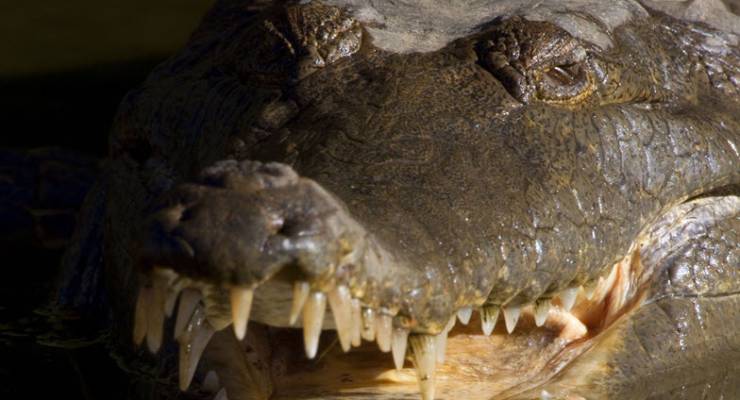
For the urbanites among us, whose mornings consist of hurriedly sipping coffee while we jostle off the tram, running 10 minutes late for our office jobs, where our ensuing days are spent tapping away under fluorescent lights and imbibing yet more coffee, a crocodile is as other-worldly as the dinosaurs it is so closely related to. But for our brethren up in the wild and sweaty north, crocodiles are a tense and unsettling reality. Especially now that Australia’s crocodile numbers have been restored to the same population level as they were before hunting nearly wiped them out in the late ’70s. That is to say there are about 100,000 of them living in the Northern Territory, and some 50,000 more in Queensland.
On Sunday morning, 18-year-old Lee de Paauw was mauled by a crocodile as he clambered out of the Johnstone River in Innisfail. As he was climbing out of the river, a waiting croc attacked De Paauw and latched onto his arm. The teenager eventually freed himself by repeatedly punching the croc in the head and was helped from the water by his friends.
News of this crocodile attack comes one day after a 35-year-old spear fisherman was reported missing when his empty dinghy and spear gun were found floating in waters just north of Innisfail on Saturday.
It is no surprise that the debate around whether or not we should “manage” croc populations reignites when attacks like this take place. It seems to be human nature to wonder, as our population grows and we encroach further onto traditional croc habitat, whether crocodile numbers ought to be somehow reduced, and therefore the threat to human life decreased.
In the eyes of Graham Webb, renowned crocodile expert and owner of Crocodylus tourist park in the Northern Territory, managing populations is a “common sense call”.
“You can’t sugar coat-crocs,” he said. “It’s easy for people to say that this kid was silly, but young people do things that are a little bit risky sometimes” and they should be able to emerge from their period of risk-taking behaviour with their lives, Webb believes.
There’s mixed conjecture around the most effective approach to reducing incidences of crocodile attacks. While the word “cull” might not sit well with some, others are much more likely to see it as a logical next step to co-existing with crocodiles. Or as Webb asserts, “the value system needs to change … you can’t have the same value system for an endangered species as for a predator whose population levels have been restored”.
He points out that the Northern Territory crocodile population has increased by 20 times what it was before protection, and the biomass (meaning the size and weight of the crocodiles) has increased by 100 times. This is to say that the majority of crocodiles living in the NT are larger animals, with some measuring up to four metres long.
On the topic of crocodile management, Webb would probably describe himself as a realist, and his views may ruffle the feathers of the Bondi urbanite he ascribes to the anti-culling group. “We’re looking at trophy hunting in the NT,” he said when asked about culling. “We would like to have an upmarket hunting industry … that way a hunter from Austria or somewhere who wants to shoot a big croc can come out and do that, he can pay five to ten thousand dollars to the land owner and shoot a crocodile.” Webb believes that this would ensure that crocodiles remain a “valuable resource”, if you will. Webb believes that if the landowner can make good money out of selling crocodiles to wealthy trophy hunters, he or she would look after and preserve them rather than culling them.
Webb points out that crocodile populations have increased dramatically while the population of certain tiger sub-species have continued to decrease worldwide, despite conservation efforts. “That’s because nobody benefits from tigers,” he said; they’re protected and therefore to “use” them, in the way that crocs are used and sold as commercial resources in the NT, is illegal. Webb seems to think that might be the problem. “When it comes to predators the word is pragmatism.”
A slightly alarming suggestion from NT researchers has found that as crocodile populations increase and vicious turf wars break out between these territorial animals, smaller and weaker crocodiles are making their way further south than they’ve ever been before. In light of this, the Queensland government has announced plans to embark on its first ever comprehensive crocodile count, which will give rangers and researchers a clear idea of exactly how many crocs call Queensland home. Even if this count proves that Queensland’s crocodile population is thriving, Queensland Environment Minister Steven Miles has confirmed that he favours removal of crocodiles rather than a cull.
Whatever approach is taken towards growing crocodile populations in the NT and Queensland, one things is clear: the water is pretty muddy on this one.








Let the Aboriginals make a quid. In the 70s there were way lees people, but crocs may well invade areas where have never been seen as the water warms.
One could only enter a northern waterway safely (and exit it alive!) if ALL estuarine crocodiles over 2 metres or so had been killed, so a bare reduction in croc numbers wouldn’t make it any safer. Whether there are 3 or 10 crocodiles that are potentially dangerous to humans in a certain area makes not much difference; if only one of them is hungry enough you’ll be eaten if you jump in or walk too close to the water’s edge.
“It’s easy for people to say that this kid was silly, but young people do things that are a little bit risky sometimes” and they should be able to emerge from their period of risk-taking behaviour with their lives, Webb believes.
How stupid such a remark is becomes clear when you compare it with the dare of running across a busy freeway at rush hour or surfing a train. Nobody would call for the culling of vehicles or trains in the case of a serious or fatal accident.
The spear fisherman entered the territory of crocs and sharks knowing about the dangers. Even culling some of the crocs around Cairns wouldn’t have diminished the danger to him.
I used to live in Darwin and never went into potentially croc-infested water, and neither did I let my dog get close to the edges. I don’t consider it some sort of civil right to be able to enter wild animals’ territories. If someone else wants to share these spaces with them, that’s their choice and, above all, their risk.
As for the idea of an “upmarket hunting industry”: The total crocodile numbers would probably support such an industry, provided it was well regulated AND POLICED, but it would need clear stipulations as to the maximum size of crocs that could be shot. It takes decades for estuarine crocodiles to reach a length of 3 or 4 metres. Knowing hunters, a small one wouldn’t do, but we don’t want to lose the big ones, do we?
Angelika Kriesel
I live in “croc territory” and take risks, such as canoeing in crocodile habitat. I am very ambivalent about a cull and totally opposed to the obscenity of trophy hunting in any form. This isn’t a “Bondi issue” – I’m sure the average Bondi swimmer would also be opposed to a shark cull.
The spear fisherman was likely swimming in open water that he knew crocodiles inhabited. The young bloke with the chomped arm, contrary to the highly inaccurate account above, jumped in as a bet to impress a lass – a bet he won, but almost at the cost of his life.
It’s funny how our number one predator is being thought to jump at boats for food….. hmmmm to me it’s just plain dumb teaching them that,especially now their population has increased the same as their size,
This is where those that have the knowledge about such animals, should be allowed to make the decisions, not those that as was noted have no experience or knowledge about this most ancient of species. I suggest we acknowledge that there are always going to be people that are silly enough to take risks. But why should a whole species shoulder the responsibility of what only amounts to a relatively small amount of deaths each year, when you compare it to the death rates on our roads each year.